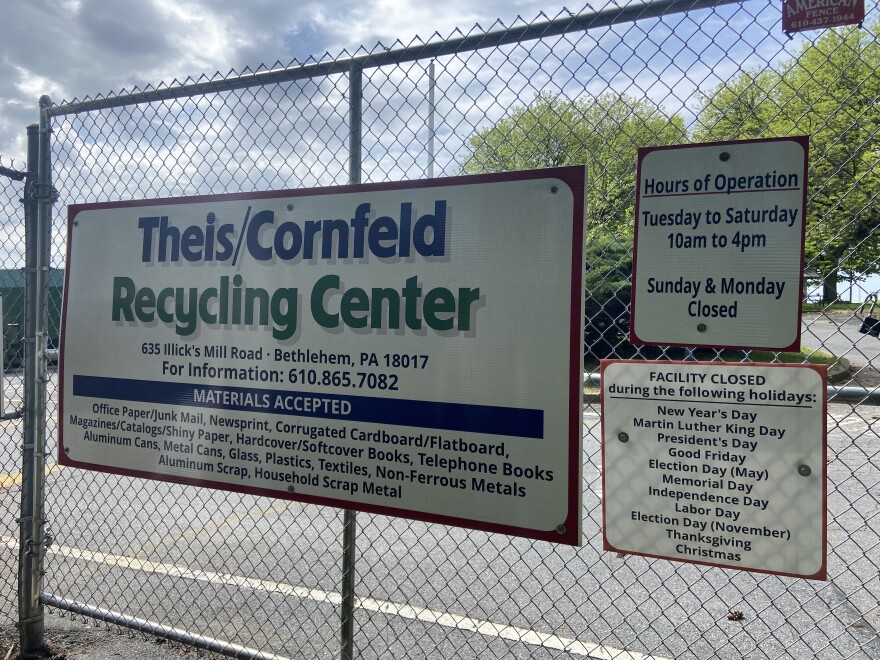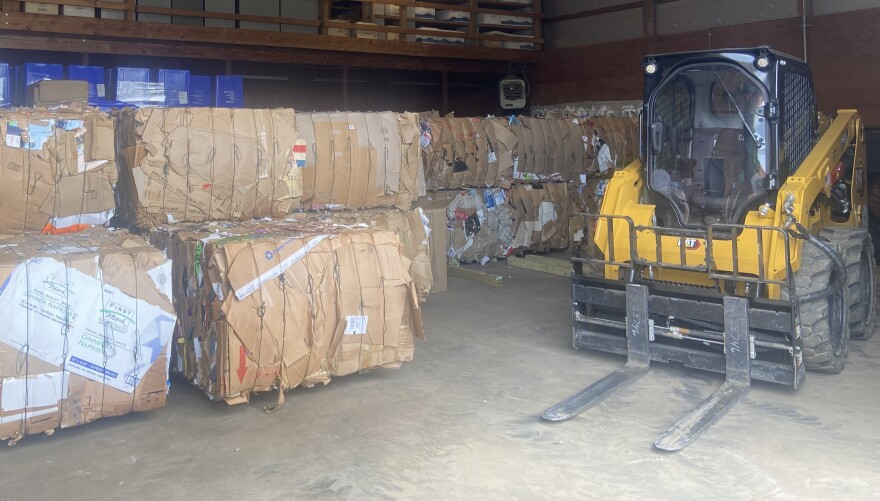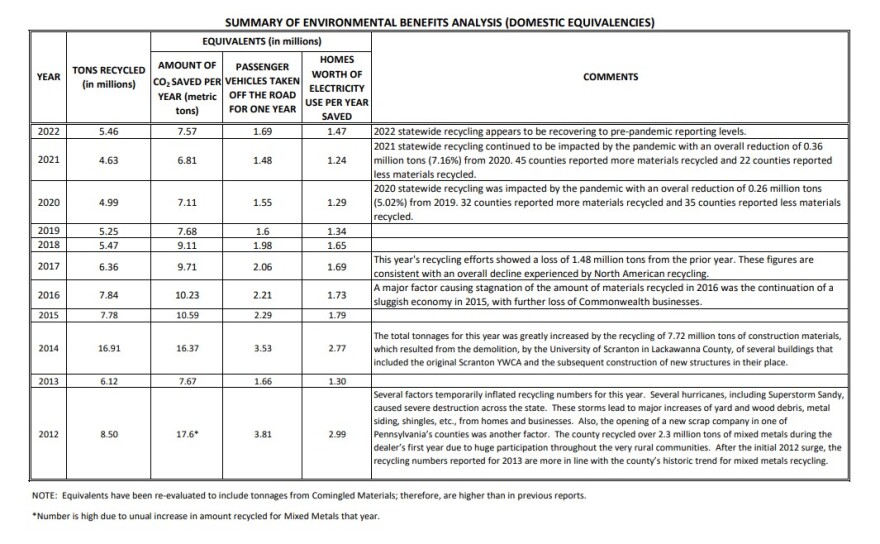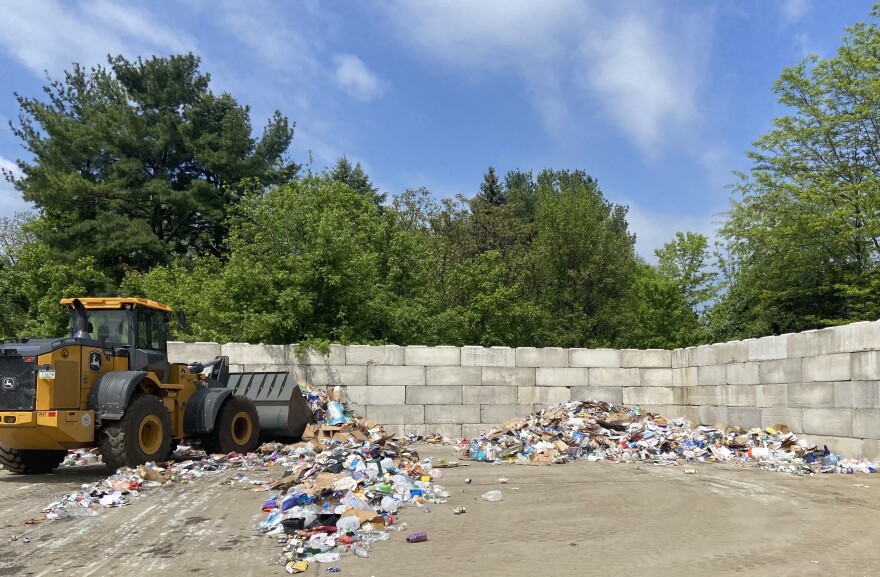BETHLEHEM, Pa. — A steady line of cars, trucks and SUVs turned off Illick's Mill Road, through the open chain link gate and into the Theis/Cornfeld Recycling Center.
After parking, drivers unloaded their recyclables and took them to a corresponding area.
Each type of item accepted had its own hulking green metal container, clearly labeled — including metal, cardboard, textiles, glass, plastics and newsprint, among others.
Workers, easy to spot in their highlighter-yellow, city-branded uniforms, directed the flow of drop-offs.
“It’s like this all day long.”Bethlehem Recycling Director Mike Halbfoerster
As if efficiently choreographed, dozens of vehicles passed through, each one leaving a little lighter than it arrived.
“It’s like this all day long,” Bethlehem Recycling Director Mike Halbfoerster said. “We do anywhere between, on a slow day, 150 cars, and, on a busy day, over 500.
“Tuesdays are generally one of our busier days. We have a lot of parking spots, but a lot of them are full.”
‘I've seen it; I know’
The center, open five days a week year-round, accepts recyclables not only from city residents, but the general public, too.
Helmed by Halbfoerster, a Lehigh Valley native with decades of experience in the industry, it provides a place for those who don’t have municipal recycling services, or have too much to leave at the curb.
However, the center also is a connection point, bridging the gap between residents and the recycling process.

Whilethe general consensus is that recycling is good for the environment, there still are some for whom the process is entirely nebulous at best, or, at worst, misconstrued and misunderstood.
At Theis/Cornfeld, residents can see, first-hand, how it works.
“It’s lack of familiarity and lack of education,” Halbfoerster said.
In the industry for 35 years, he said he’s come up against his fair share of those who don’t believe their recyclables actually get recycled after they’re collected at the curb.
“I'm not here to make a profit. We're here to make sure that we recycle. We do the environmentally correct thing. Everything that gets diverted here stays out of a landfill.”Bethlehem Recycling Director Mike Halbfoerster
“I know how it works, how it operates," he said. "I've seen it; I know.”
Traffic continued to move through the center, car trunks and doors slamming to punctuate the sounds of tinkling glass and clanging metal.
Two attendants manned the cardboard baler, easily the busiest of all stations, as the mammoth machine constantly whined, compressing material before spitting out bales of corrugated cardboard and flatboard, each 800 to 1,200 pounds.
“I'm not here to make a profit,” Halbfoerster said. “We're here to make sure that we recycle. We do the environmentally correct thing. Everything that gets diverted here stays out of a landfill.”
‘Philosophy of the recycling bureau’
The city’s recycling bureau is divided into three parts: curbside, the center and a yard waste facility, which also has compost.
Headquartered at City Hall, 10 E. Church St., two office workers field calls that often are asking what’s accepted.
“On average, we get anywhere between as little as 50 calls a day to 300 calls a day,” Halbfoerster said. “The philosophy of the recycling bureau here for the city is this: We can't recycle everything. We can't take everything.
“But what we cannot take or what we cannot handle, we try to refer people to other outside sources.”
The center doesn’t offer shredding services, or electronics recycling. Pizza boxes aren’t allowed, due to the risk of contamination. Plastic bags are a tangling hazard.
The center also stopped taking Styrofoam after its machine reached the end of its useful life and was not replaced.
“We're all here to answer questions, to provide people with the education.”Bethlehem Recycling Director Mike Halbfoerster
“People may not be happy if they have to drive to Allentown, or maybe over to Easton, for certain things, but at least there's options out there for them if we can't do it ourselves,” he said.
“We're all here to answer questions, to provide people with the education.”
‘Rebate on some, not all, of it'
Behind the Recycling Center, joined by a narrow stretch of road between recreation fields and a golf course, is the city’s yard waste and composting center.
Accessed at 1480 Schoenersville Road, it’s only open to residents of the city, as well as Hanover Township and Fountain Hill, with a compost card.
Two large pole buildings, used to store bales, residential recycling cans and trucks, are tucked nearby, as is a large concrete pad, called a bunker, where recycling trucks drop off single-stream collections.
A bright yellow loader scooped the material into another metal container.

Between 4,000 and 4,300 tons of curbside material pass through the facility each year, Halbfoerster said.
Once a container is filled, or there are 20 or so bales of cardboard and flatboard stacked, the recyclables leave the city, going to Cougle's Recycling in Schuylkill County.
“We get a rebate on some of it. Not all of it,” he said.
“Newspapers, we usually break even or we pay a little bit to get rid of. Corrugated cardboard we get paid for because we bale it. Glass, not so much; plastic, sometimes — it just depends on the market.
“Where we make up on what we lose is on the metal. Cardboard usually pays out pretty well. So where we may lose on glass and plastics, we make up for on cardboard and other stuff.”
Statewide, local recycling data
The commonwealth has a recycling database, where municipal and county recycling data is collected and maintained.
In 2022, more than 5.46 million tons of recyclable materials were collected and processed statewide, according to the state Department of Environment Protection.
“This removed the equivalent of more than 7.57 million metric tons of carbon dioxide emissions from the air,” according to the agency’s website.
“This number is equal to over 1.69 million passenger vehicles taken off the road for one year.
“These same recycled resources are also equal to eliminating the electricity used in nearly 1.47 million homes per year.”
It was a sharp increase from the two previous years, the start and height of the COVID-19 pandemic, during which recycling saw a downturn.

From 2021 to 2022 alone, recycling increased 17.9%, according to state data.
“In 2022, 32 counties reported more materials recycled and 35 counties reported less materials recycled,” according to the agency.
“As expected, overall recycling tonnages in Pennsylvania have increased as the impacts of the pandemic become more distant.”
Recycling ups and downs
While the state’s website doesn’t display municipal data, it does show how much each county reported going back more than two decades — and the Valley is recycling less.
Recycling in Lehigh and Northampton counties in 2021 and 2022 fell from 142,568 tons to 140,866 tons and 138,308 tons to 130,718 tons, respectively.
While 2023 data, through the state or the city, is not yet available, Halbfoerster said it seems recycling is on an upward trajectory.
“I think as more people become involved, and some of these smaller municipalities start to realize that there's benefits. It saves landfill space, it’ll reduce your carbon footprint. I think we do see that happening."Bethlehem Recycling Director Mike Halbfoerster
“I think as more people become involved, and some of these smaller municipalities start to realize that there's benefits," Halbfoerster said.
"It saves landfill space, it’ll reduce your carbon footprint. I think we do see that happening.
“We've seen an uptick in last year's numbers versus 2022 on the curbside. We saw about an 8 percent increase.”
The city’s recycling department operates on an annual budget of about $2.6 million; it also gets grant money from the state for the material collected.
Halbfoerster compiles the yearly report, called Recycling Program Performance Grants, for the application.
“It's not only what we do here, but it's citywide,” he said. “All the commercial businesses have to report to us what they get, and that, honestly, could be 40-to-50,000 pounds of material that the city gets credit for recycling within its city limits. That's a lot of material.”
Any grants go to the city’s general fund, where the money is reinvested to maintain the center, its trucks and other equipment, he said.

‘What we’re here for’
At the recycling center, signs speckle the chain link fence, urging drivers to slow down and to back out carefully. Bright orange cones keep a safe distance between vehicles and the containers.
Safety is paramount, Halbfoerster said. In the facility’s more than three-decade history, there have been two deaths.
In 2002, Edwin Theis Jr., 80, and Lewis D. Cornfeld, 71, died after a pickup truck crushed them against the baler. The 80-year-old woman who hit them wasn’t charged, but officials took her driver’s license.
“That's why the facility is named — after the two gentlemen that gave their lives for working here,” Halbfoerster said. “We’re very safety-sensitive around here.”
The facility only closes during regular hours when the real-feel temperatures get close to 100 degrees or zero degrees. Or, if lightning begins to strike.
Asked whether there was anything on Halbfoerster’s wishlist for the center, he didn’t bring up new equipment or facilities.
He returned to education, and he and his staff’s willingness to participate in engaging with residents.
“I really wish if people didn't understand what we do, rather than guess or assume, just call us,” he said.
“As knowledgeable as I am in this industry for being in it for so long, our staff members at the office are knowledgeable in it as well.
“They know what we do, they know what we can and cannot take and, you know, sometimes just a little bit of information goes a long way rather than assuming and just showing up.
"It’s what we’re here for.”


